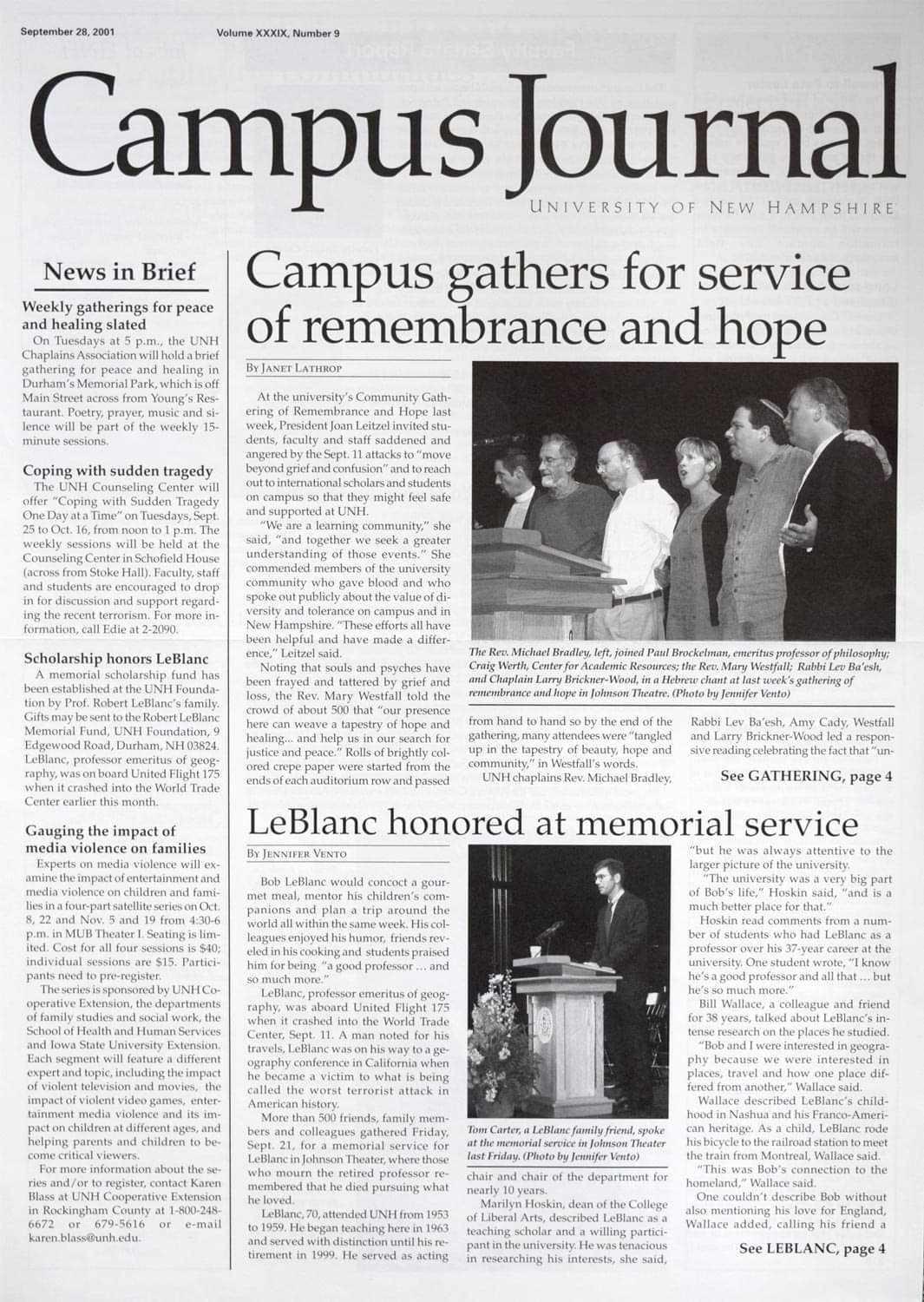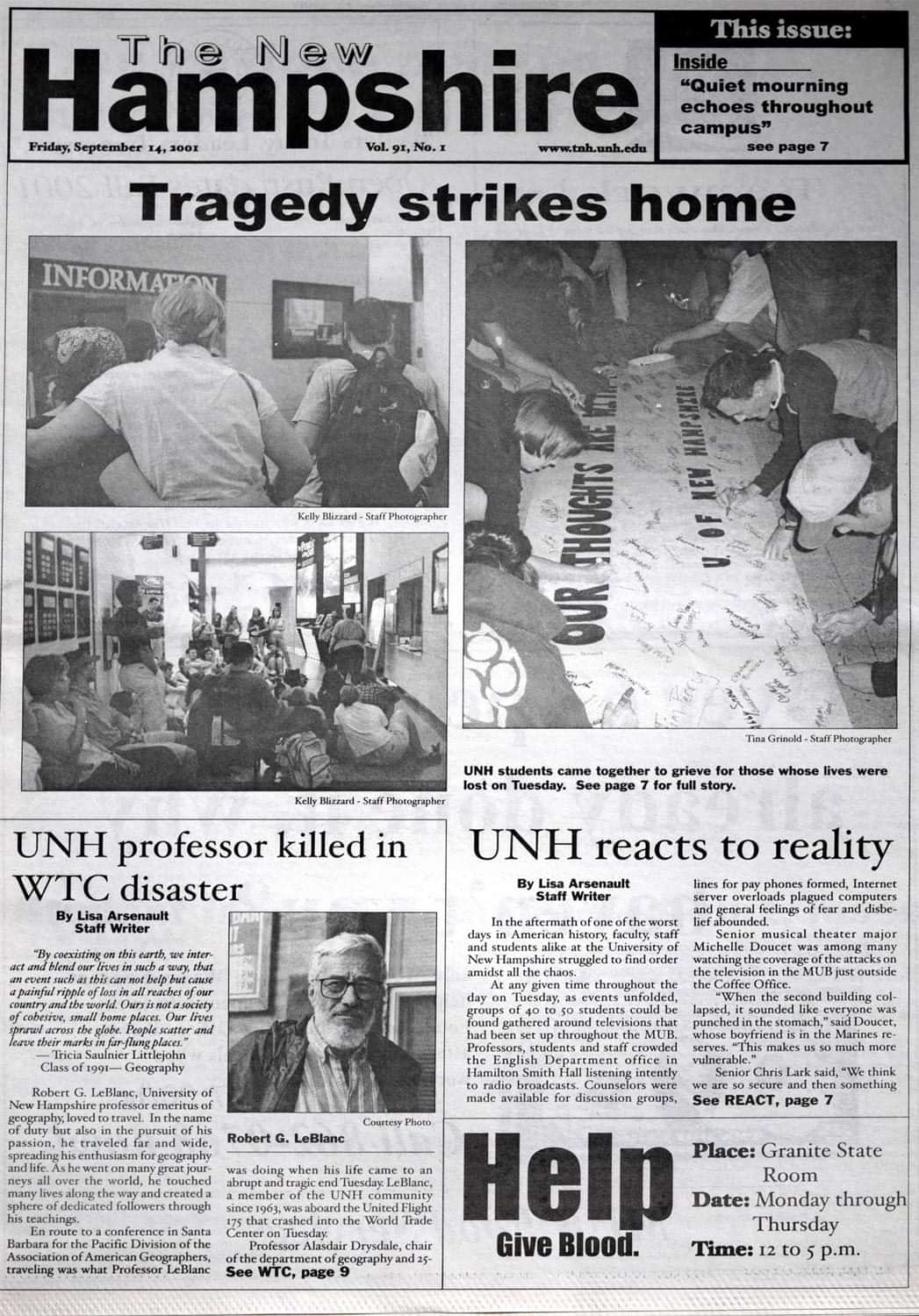Solemn Anniversary
This past fall,as the country marked the 20th anniversary of the Sept. 11 terrorist attacks, UNH Magazine asked some of the key people on campus that day in 2001 to recall their experiences — and looked at how today’s students are being educated about this piece of American history.
Kim Billings, then director of the UNH News Bureau, recalls the phone call from the dean of the College of Liberal Arts on Sept. 11, 2001; that a plane had hit the World Trade Center. “I yelled out ‘Something’s happening in New York City!’ and everybody went into the conference room,” Billings recalls. The office in Schofield house had just purchased a television, and so, before the era of smartphones, gathering around a television was the fastest way to find out what was happening. More faculty and staff joined the crowd in Schofield House, as a second plane hit the World Trade Center, and a third crashed into the Pentagon.


UNH Archives
“I’m pretty sure Bob LeBlanc was on one of those flights.”
Robert LeBlanc ’59 had been a geography professor at UNH for 36 years. After graduating, he helped build UNH’s geography program from the ground up. A lifelong traveler and explorer, he was known as someone who used geography to study culture and people — he was insatiably curious, and believed immersing oneself in a culture was only way to truly understand others. He was on his way to a geography conference in Los Angeles the morning of Sept. 11, 2001.
UNH would receive confirmation of his death from LeBlanc’s family: He was on United Airlines Flight 175. Word would also come that three alumni were killed in the attacks: Judd Cavalier ’98, Jennifer Fialko ’94 and Timothy C. Stout ’83. (You can read remembrances by their colleagues and fellow alumni in the Winter 2002 edition of UNH Magazine).
President Joan Leitzel, who led UNH from 1996 to 2002, recalls being grateful it was a beautiful September day, as it was meant to be a busy one. Among her tasks was a breakfast meeting with alumnus Bob Towse ’63, and she had her State of the University address to deliver later in the day. It was during breakfast with Towse that they were informed about the first plane. Towse was with Morgan Stanley at the time, and upon hearing the news, rushed to get to New York. And Leitzel rushed back to her office — an emergency team of faculty, administrators and safety officials was pulled together to navigate the crisis on campus. Counselors were made available, staff connected with both international students on campus and students studying abroad. A campus-wide service of mourning was planned, as was a blood drive. Hour-by-hour updates on the news were the topics of conversation everywhere on campus.
“It was having those conversations about these terrorist events, especially between students and their teachers, reflecting on them and trying to find meaning. … It was an experience no one had ever had before, but which we shared deeply,” recalls Leitzel.
Later that week, she had lunch in one of the dining halls and talked with students about how they were feeling. “Their minds were very much on the tragedies, and it impressed me what a strong community UNH is. People here had a great deal of concern and sympathy for those who knew people who were killed. Nobody was alone, I would say.”
Last fall, UNH marked the 20th anniversary by first chiming out the T-Hall bells at 8:46 a.m. in recognition of the time the first World Trade Center tower was struck by a plane. At the football game that evening, the Durham Fire Department provided a ladder truck that displayed a large American Flag alongside the field throughout the game. Members of the UNH Army ROTC, UNH Police Department, and Durham and McGregor EMS joined the UNH marching band during the National Anthem and America the Beautiful, as well as for a moment of silence in remembrance.
Today, current UNH students — most of whom were born a few years after the attacks — are learning about them in context of current events. Associate Professor Terry O’Sullivan teaches the course political violence and terrorism as part of UNH’s homeland security degree, and says in class he helps students see parallels between the Sept. 11, 2001 attacks and the current threat of domestic terrorism, such as that seen in the Jan. 6, 2021 riot at the U.S. Capitol.
“The main thing I try to convey is how radicalization works, and the diversity of motivations behind somebody who becomes radicalized and then decides to go that next step toward violence,” says O’Sullivan, who has been a researcher at the University of Southern California’s Center for Risk and Economic Analysis of Terrorism Events (CREATE), a Department of Homeland Security Academic Center of Excellence. “The fascinating thing is that the process of becoming radicalized is very similar in many ways.”
For Leitzel, the memories of that day also include thoughts of how the UNH community processed the tragedy.
“My strongest memory is that it was a time to be together,” says Leitzel, recalling the spontaneous gatherings of people on Thompson Hall Lawn — sometimes small and silent, sometimes large, with music or spoken words. “It was a profound moment; it was the time to be a community.”
— Michelle Morrissey ’97